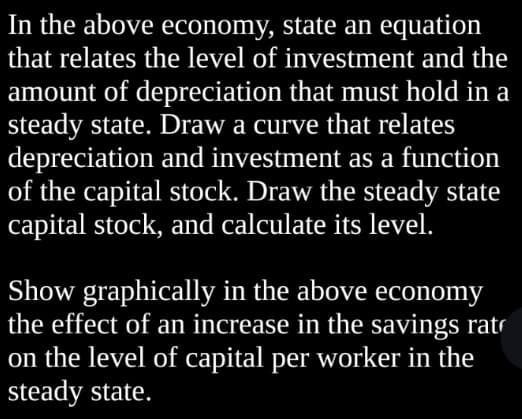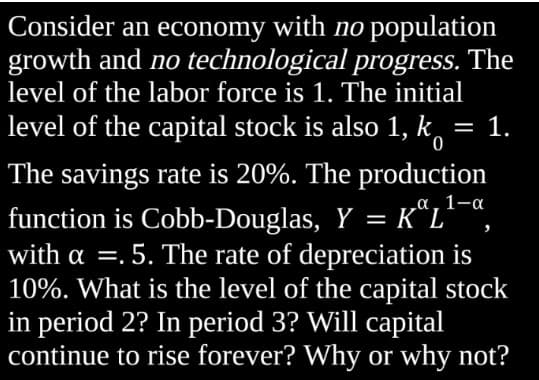In the above economy, state an equation that relates the level of investment and the amount of depreciation that must hold in a steady state. Draw a curve that relates depreciation and investment as a function of the capital stock. Draw the steady state capital stock, and calculate its level. Show graphically in the above economy the effect of an increase in the savings rat on the level of capital per worker in the steady state. Consider an economy with no population growth and no technological progress. The level of the labor force is 1. The initial level of the capital stock is also 1, k = 1. 0 a 1-a The savings rate is 20%. The production function is Cobb-Douglas, Y = KªL¹ª, with a .5. The rate of depreciation is 10%. What is the level of the capital stock in period 2? In period 3? Will capital continue to rise forever? Why or why not?
In the above economy, state an equation that relates the level of investment and the amount of depreciation that must hold in a steady state. Draw a curve that relates depreciation and investment as a function of the capital stock. Draw the steady state capital stock, and calculate its level. Show graphically in the above economy the effect of an increase in the savings rat on the level of capital per worker in the steady state. Consider an economy with no population growth and no technological progress. The level of the labor force is 1. The initial level of the capital stock is also 1, k = 1. 0 a 1-a The savings rate is 20%. The production function is Cobb-Douglas, Y = KªL¹ª, with a .5. The rate of depreciation is 10%. What is the level of the capital stock in period 2? In period 3? Will capital continue to rise forever? Why or why not?
Chapter1: Making Economics Decisions
Section: Chapter Questions
Problem 1QTC
Related questions
Question

Transcribed Image Text:In the above economy, state an equation
that relates the level of investment and the
amount of depreciation that must hold in a
steady state. Draw a curve that relates
depreciation and investment as a function
of the capital stock. Draw the steady state
capital stock, and calculate its level.
Show graphically in the above economy
the effect of an increase in the savings rat
on the level of capital per worker in the
steady state.

Transcribed Image Text:Consider an economy with no population
growth and no technological progress. The
level of the labor force is 1. The initial
level of the capital stock is also 1, k = 1.
0
a 1-a
The savings rate is 20%. The production
function is Cobb-Douglas, Y = KªL¹ª,
with a .5. The rate of depreciation is
10%. What is the level of the capital stock
in period 2? In period 3? Will capital
continue to rise forever? Why or why not?
AI-Generated Solution
Unlock instant AI solutions
Tap the button
to generate a solution
Recommended textbooks for you


Principles of Economics (12th Edition)
Economics
ISBN:
9780134078779
Author:
Karl E. Case, Ray C. Fair, Sharon E. Oster
Publisher:
PEARSON

Engineering Economy (17th Edition)
Economics
ISBN:
9780134870069
Author:
William G. Sullivan, Elin M. Wicks, C. Patrick Koelling
Publisher:
PEARSON


Principles of Economics (12th Edition)
Economics
ISBN:
9780134078779
Author:
Karl E. Case, Ray C. Fair, Sharon E. Oster
Publisher:
PEARSON

Engineering Economy (17th Edition)
Economics
ISBN:
9780134870069
Author:
William G. Sullivan, Elin M. Wicks, C. Patrick Koelling
Publisher:
PEARSON

Principles of Economics (MindTap Course List)
Economics
ISBN:
9781305585126
Author:
N. Gregory Mankiw
Publisher:
Cengage Learning

Managerial Economics: A Problem Solving Approach
Economics
ISBN:
9781337106665
Author:
Luke M. Froeb, Brian T. McCann, Michael R. Ward, Mike Shor
Publisher:
Cengage Learning

Managerial Economics & Business Strategy (Mcgraw-…
Economics
ISBN:
9781259290619
Author:
Michael Baye, Jeff Prince
Publisher:
McGraw-Hill Education